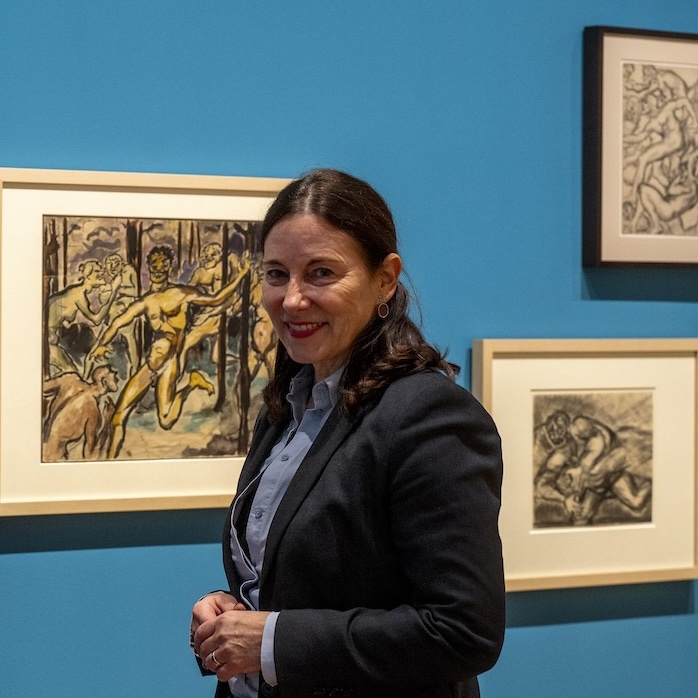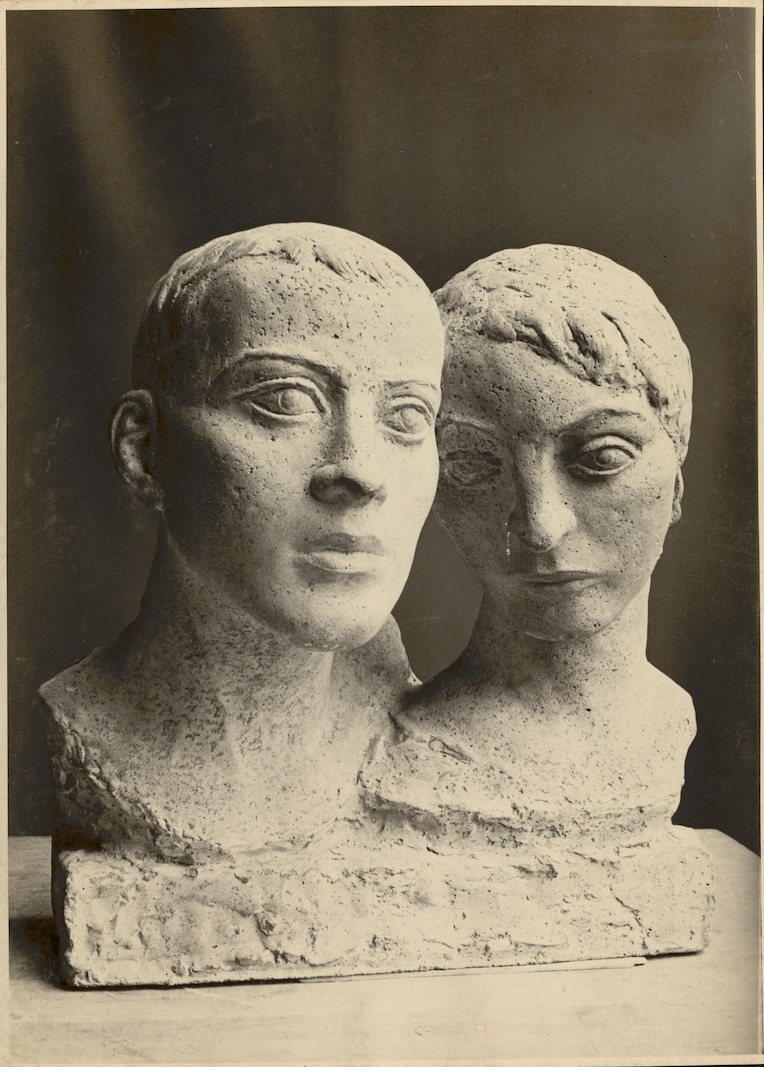Jewish Artist

Samson Schames: Fragments of Exile
Lecture by Annika Friedman, Frankfurt
ONLINE
VA, United States
This event is sponsored by Ilona Oltuski in memory of Ruth Drory. Image above: Samson Schames, Kindling of the Lights, c. 1956. Glass tiles on glass, 56 x 71 cm. Jewish Museum Frankfurt Samson Schames (1898-1967) came from a long-established Jewish family in Frankfurt am Main. With the support of his uncle, renowned gallery owner Ludwig Schames, he made his way into the 1920s art scene and began his training as a painter, graphic artist, and stage designer. Schames’ designs, drawings, and oil paintings from the period up to 1933 testify to his deep connection to Frankfurt and her landscapes. Samson Schames, Opernplatz Frankfurt, 1930. Jewish Museum Frankfurt [...]

The Art of Marc Klionsky:
Shaping a Three-World Condition from Minsk to New York
Lecture by Ori Z Soltes and conversation with daughter Nadia Klionsky
ONLINE
VA, United States
In this program Georgetown University professor and author, Ori Z Soltes, explores Marc Klionsky's life and work, in part through conversation with his daughter, the scholar and artist, Nadia Klionsky. Image above: Marc Klionsky, Dizzie Gillespie: The Man and his Trumpet, 1988. Oil on canvas, 52 x 66 inches. National Portrait Gallery, Washington, DC. This exciting program features the paintings of Marc Klionsky (1927–2017). Born in the Soviet Union, Klionsky managed to navigate what has been called a “two-world condition”—creating the particularized Soviet Socialist Realist work that was acceptable to the Stalinist and post-Stalinist State while allowing his soul to reveal itself in work that only a very few trusted viewers might see. As [...]

“Let’s Talk of Interesting People”:
The Story of Erna Friedländer (1890-1979)
With Noit Banai, PhD, Hong Kong, and Ketul Arnold, Boulder (Colorado)
ONLINE
VA, United States
This presentation by Noit Banai, PhD, Hong Kong, and Ketul Arnold, Boulder (Colorado), traces Erna Friedländer‘s unique journey as a German refugee who survived Nazi persecution and World War II in Hong Kong, and subsequently migrated to England, Israel, and the USA. Image above: Erna Friedländer, Chinese Landscape. Undated. Monotype. Courtesy The Studio: An Illustrated Magazine of Fine and Applied Art, London As a German refugee who survived World War II in Hong Kong, and subsequently migrated to England, Israel, and the USA, Erna Friedländer’s journey is unique among the many histories of Jewish dispossession. Though few traces remain of Friedländer artistic oeuvre, she was a thoroughly modernist artist. Painter, printmaker, and teacher at the [...]

Sculpting a Life: Chana Orloff during Occupation, Escape, Exile, Return (1938-1949)
Presentation by Paula J. Birnbaum, San Francisco (CA)
ONLINE
VA, United States
This talk analyzes the Ukrainian born French sculptor Chana Orloff’s (1888-1968) perseverance and tremendous sacrifices during World War II, when the Nazis came to her studio, stole much of her work, and brutally vandalized what they left behind. Her tenacity led to her narrow and difficult escape from Paris first to the south of France and then on to Geneva with her young adult son, who was disabled. The presentation explores how Orloff managed her life and career under Nazi Occupation in Paris for two years, when she was among the many French and foreign-born Jews banned from public spaces, forced to observe a curfew and wear the yellow armband with the Star of David and the word “Juif” [...]

Fritz Ascher in Berlin – eine Spurensuche
Kurzvortrag und Führung von Rachel Stern, New York
Augustinermuseum, Haus der Graphischen Sammlung, Freiburg
Augustinermuseum
Augustinerplatz, Freiburg im Breisgau
Der spätexpressionistische Künstler Fritz Ascher (1893-1970) überlebte zwei Weltkriege und die Verfolgung durch das nationalsozialistische Regime. Als aufmerksamer Beobachter der Schrecken des Ersten Weltkriegs und der revolutionären Unruhen wandte er sich christlich-spirituellen Themen zu, die er radikal neu interpretierte. In intimen Zeichnungen beschäftigte er sich ab 1916 mit dem Thema Liebe und Verrat, sowohl in seiner Auseinandersetzung mit dem Kreuzigungsthema als auch mit der Figur des Bajazzo in der tragikomischen Oper „I Pagliacci“. Kurzvortrag und Führung von Rachel Stern zeigen den Künstler in seinem sozialen und politischen Umfeld. Image above: Fritz Ascher, Im Wald, um 1919. Weisse Gouache und schwarze Tusche über Aquarell und Bleistift auf Papier, 34 x 32,2 cm © Bianca Stock The late expressionist [...]

Liebe und Verrat: Fritz Ascher
Kurator Erik Riedel im Gespräch mit Rachel Stern
Jüdisches Museum Frankfurt (Germany)
Jewish Museum Frankfurt
Bertha-Pappenheim-Platz 1, Frankfurt am Main, Germany
Der Maler, Grafiker und Dichter Fritz Ascher (1893-1970) wurde bereits als 16-Jähriger von Max Liebermann an die Akademie in Königsberg empfohlen. Ab 1913 gehörte er zu den gefragten Malern in Berlin. Er war ein genauer Beobachter seiner Zeit; die Urkatastrophe des Ersten Weltkriegs und die revolutionären Unruhen in Berlin führten ihn zu christlichen und mystischen Themen, die er radikal neu interpretierte. Nach 1933 erhielt Ascher als Jude Berufsverbot. Während der Pogrome am 9./10. November 1938 wurde er verhaftet und im Konzentrationslager Sachsenhausen und im Potsdamer Gestapo-Gefängnis interniert. Die Schoa überlebte er ab 1942 versteckt in einem Keller in Berlin-Grunewald. Während dieser einsamen Jahre verfasste er Gedichte. Als Künstler fand Ascher nach 1945 seinen ganz eigenen Stil. Angeregt vom nahe [...]

Felka Platek – Artist and Companion of the Painter Felix Nussbaum
Presentation by Anne Sibylle Schwetter, Osnabrück (Germany)
ONLINE
VA, United States
Felka Platek (1899 Warsaw – 1944 Auschwitz) came to Berlin from Warsaw in the early 1920s to become a painter. In 1932 she followed her friend and later husband Felix Nussbaum (1904 Osnabrück – 1944 Auschwitz) to Italy. In 1935 they decided to go into exile in Belgium. However, neither of them could escape persecution by the Nazis. They were captured in their hiding place in Brussels on June 21, 1944 and murdered in Auschwitz shortly afterwards. Image above: Felka Platek, Self-portrait in front of an open window, around 1940. Gouache on drawing paper, 65 x 49.7 cm. Felix-Nussbaum-Haus at Museumsquartier Osnabrück, on permanent loan from the Felix Nussbaum Foundation, photo © Felix-Nussbaum-Haus Osnabrück Anne [...]

Gertrud Kauders, Jewish Artist from Prague (1883-1942):
Surprises, Enigmas, Opportunities
Presentation by Simon During, Brisbane (Australia)
ONLINE
VA, United States
While workmen were demolishing a house on Prague’s outskirts in July 2018 they were astonished to be deluged by works of art falling from a ceiling. Nobody knew the works had been hidden there. The art turned out to be that of Gertrud Kauders who had hidden them in the house of a friend before being deported to Theresienstadt and then to Majdanek where she was murdered on arrival in May 1942. Kauders was a serious and inventive artist, quite well known in Prague’s art world of the time. She worked in oils, pencil, crayon, watercolour and gouache. Now her work is held by museums around the world. Image above: Gertrud Kauders © Kauders Family Estate [...]

Love, Betrayal and Ascher’s Unpainted Pictures
Tour by Exhibition Curator Jutta Götzmann
Haus der Graphischen Sammlung, Freiburg (Germany)
Haus der Graphischen Sammlung
Salzstraße 34, Freiburg im Breisgau, Germany
Jutta Götzmann, exhibition curator of "Love and Betrayal," presents the artist Fritz Ascher (1893-1970) during a tour. In addition to early charcoal, graphite and ink drawings, colorful gouaches are fascinating. Poems that are considered his "unpainted pictures" and were created in secret during the National Socialist era complement the exhibition. BUY TICKETS HERE The Fritz Ascher Society is a not-for-profit 501(c)3 organization. Your donation is fully tax deductible. YOUR SUPPORT MAKES OUR WORK POSSIBLE. THANK YOU. DONATE HERE

Fred Kormis – Sculpting the Twentieth Century
Presentation by Barbara Warnock, London (England)
ONLINE
VA, United States
Born in 1894 in Frankfurt into an Austrian and German Jewish family, Fred Kormis’ life and career were shaped and disrupted by some of the most significant events of the twentieth century. Kormis saw action and was wounded in the First World War as part of the Austrian army, before being held for four years as a prisoner of war in Siberia. Image above: Fred Kormis, Two Heads, c. 1930s © Wiener Holocaust Library Collections He worked as an artist during the politically and culturally tumultuous Weimar period, and during the Nazi era revealed himself to be Jewish, a decision that led to the removal of his art from galleries. Kormis and his wife Rachel Sender [...]


